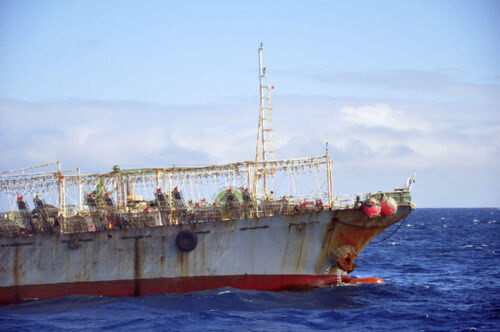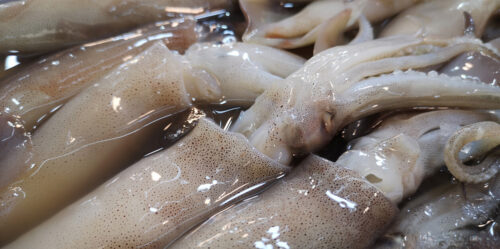
Elena Ojea is a senior researcher at the University of Vigo where she founded the Future Oceans Lab, a Vigo-based research group on marine systems and climate change. Dr. Ojea holds an undergraduate degree in Environmental Sciences and a PhD in Economics, and was a postdoc and research fellow at the Basque Centre for Climate Change. We first met Elena while she was a visiting researcher with our partners at the University of California, Santa Barbara. In celebration of this year’s Earth Day theme, Climate Action, we sat down with Elena to learn more about her research.
Q: Why is studying fisheries in the face of climate change important?
Oceans cover over 70% of the Earth’s surface and provide so many supporting services to us, with fisheries being one of the most important sources of food, industry, and small-scale livelihoods throughout the world. At the same time, climate change is a global phenomenon caused by anthropogenic emissions that have no barriers. Climate change is having a huge impact on the oceans and therefore fisheries.
Q: What are some of the main impacts of climate change on fisheries? How do these impacts vary spatially?
The climate change impacts that we know about in the oceans, both extreme events and incremental changes, are all having an effect on fisheries. With rising ocean temperatures, we are seeing geographic shifts in species abundance and distribution, as well as vertical movements within the water column. There are projections of a redistribution of species, and therefore catches, northward toward the poles with a corresponding loss in the tropics, and these impacts are consistent across models. However, while we are discovering more and more about the impacts of climate change on fish stocks and potential catches, we know much less about the potential socioeconomic consequences for fishers and the fishing industry.
Q: You mention shifts in species distribution as a major impact of climate change. As target species move out of existing fishing grounds, or into new ones, how able are fishers to adapt?
The ability for fishers to adapt to shifting stocks depends a lot on scale and whether stocks cross jurisdictional boundaries. On the one hand, the high seas fleets of many large fishing nations are already highly spatially distributed and might be prepared to follow the fish around, given new and existing agreements. On the other hand, smaller coastal vessels can only travel so far. At the level of the Exclusive Economic Zone (EEZ), we know climate change is having an impact on these small scale fisheries that are less able to move. It might seem as though climate change may have less of an impact on – or even increase – the total catch of the larger fleets, but additional impacts due to new species interactions and bycatch can be detrimental.
Things become even more complex as stocks cross jurisdictional boundaries – what incentive do you have to fish responsibly today if you know you won’t have access to the fish tomorrow? There needs to be international agreements that regulate access to different EEZs so you don’t end up with countries depleting transboundary stocks that move out of their waters. We need to know what’s happening on the high seas as well. The Arctic is another challenge – the total catch there is actually expected to increase due in part to the opening of new fishing grounds as sea ice melts. We need to create agreements for how to access these new areas without overexploiting the resources. In the meantime, and until there is enough knowledge on the ecological implications, there is currently an international moratorium on fishing in the Arctic until an agreement is reached.
Q: What are some of the shortcomings of current fisheries management with respect to climate change and what strategies can help make them more resilient?
The goal is to make the fishers’ activity more resilient. So, you can allow fisheries to transform to be more resilient as long as you have appropriate management strategies to protect against overexploitation. A flexible government framework is important so you can adapt to the new realities of the marine ecosystem and the changes that take place. It is important to promote participation and co-management. Ending harmful subsidies that continue to maintain overcapacity is also important to reduce illegal, unreported, and unregulated (IUU) fishing. You want to allow for shifting target species so fishers have more options. You also need to maintain the resilience of the marine ecosystem and that involves cutting down on other stressors – IUU activity, pollution, etc.
Q: A key objective of Global Fishing Watch is to track the global footprint of fisheries over time. How can high resolution data on the location and intensity of fishing activity help inform more resilient fisheries management?
If you’re able to observe fishing behavior in such a way as GFW data shows, you’re actually observing what the fleets are doing in response to environmental changes. Even though there’s not a huge time series of this type of tracking data, the more this time series grows, the better we’ll be able to understand global patterns.
You could look at extreme events on the oceans and look at how those events affect fishing behavior as an indicator for what might happen over time. If you look at anthropogenic extreme events – like the blob – these events happen at a scale that I expect you could study with data like GFW and you could look at how fleets adapt. They are like mini experiments that you can observe and learn how to better anticipate the types of behavior change in fisheries that can help you better plan adaptive management strategies.
Q: How can increased transparency contribute to a deeper understanding of the impact climate change has on fisheries?
We know that sustainable management in fisheries helps to lower the impact of climate change on fish stocks. But we also know that in some cases this won’t be enough – there are likely to be countries/places that still see very negative effects even with sustainable management. The best thing you can do is to implement sustainable, adaptive management and increase transparency in fisheries management. The more fishing activity we can observe, the better we can evaluate the impacts of climate change and the effectiveness of different management strategies in order to adapt accordingly.
Tyler Clavell is a data scientist at Global Fishing Watch.


